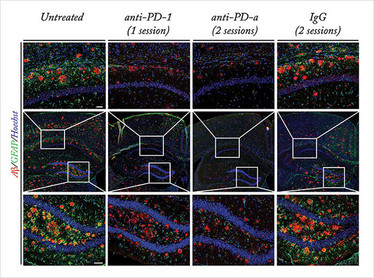
PD-1 on the Brain
Revolutionary cancer immunotherapies appear to alleviate Alzheimer’s symptoms in mice
PD-1 inhibitors nivolumab and pembrolizumab were approved in 2014 as cancer immunotherapies, making headlines by inducing complete remission in some patients with hard-to-treat advanced metastatic cancers (read more). Now it seems the PD-1 pathway could have an important role in brain pathology too, after a new study showed that PD-1 blockade improved symptoms of Alzheimer’s disease in mouse models (1).
Michal Schwartz, principle investigator and Professor of Neuroimmunology at Weizmann Institute of Science, explains the background to the study. “For the last 20 years, my research team has focused on understanding how the immune system participates in brain maintenance and repair in health and disease, and how to harness this power by peripheral immunomodulation. Prior to our early work, it was clear that brain pathologies are associated with local inflammation within the brain. Therefore, based on the old understanding of brain–immune system relationships, it was natural to try and suppress the immune system as a way of suppressing brain inflammation; however, these attempts largely failed,” says Schwartz. “But last year, we made a made a big step forward in our research when we understood that recruitment of the immune cells that locally clear accumulated toxic compounds from the brain requires activation of a unique ‘gateway’.”

PD-1 blockade reduces Aβ deposition (red) and astrogliosis (green) in the brains of Alzheimer’s disease mouse models. Scale bar, 50μm. Image courtesy of Baruch et al., (1).
In a previous study, the team demonstrated that in a mouse model of Alzheimer’s disease this gateway is dysfunctional, but can be re-activated by reducing systemic immune suppression. These findings, which suggested that peripheral immune suppression interferes with the ability to fight Alzheimer’s disease pathology, reminded the researchers of similar processes in cancer immunology. “Therefore, we decided to test whether immune checkpoint blockade – an immunotherapy which mobilizes the immune system to fight the tumor (and has revolutionized cancer treatment in recent years) – would be effective in the context of Alzheimer’s disease,” says Schwartz.
Blockade of PD-1 pathway evokes an interferon-ɣ-dependent immune response and recruitment of monocyte-derived macrophages, leading to the clearance of cerebral amyloid-β plaques – the potential mechanism behind the improved cognitive performance observed in mouse models, according to the team. “Since the suggested therapy is mechanism-driven rather than targeting symptoms of the disease, and the proposed therapies are (FDA-approved) antibodies targeting PD-1, we believe these findings could be translated in a relatively short time for clinical studies in Alzheimer’s disease,” says Schwartz.
Alongside efforts to initiate human trials, Schwartz and her colleagues are focusing on pinning down the mechanism of action. “We are currently involved in further elucidating the mechanism by which PD-1 blockade is affecting pathology in different Alzheimer’s disease mouse models. Additionally, we are collaborating with the biopharma industry to take this approach forward to the clinic,” says Schwartz.
- Baruch et al., “PD-1 immune checkpoint blockade reduces pathology and improves memory in mouse models of Alzheimer’s disease”, Nat Med 22, 135–137 (2016).
My fascination with science, gaming, and writing led to my studying biology at university, while simultaneously working as an online games journalist. After university, I travelled across Europe, working on a novel and developing a game, before finding my way to Texere. As Associate Editor, I’m evolving my loves of science and writing, while continuing to pursue my passion for gaming and creative writing in a personal capacity.















